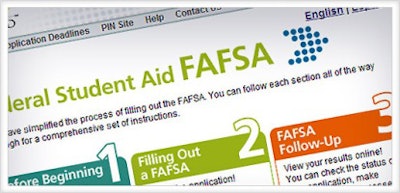 FAFSA
FAFSAIt’s widely thought the task of applying for college financial aid will become considerably easier for students and their families with the Obama administration’s just-announced move to allow early filing of the Federal Student Aid form, or FAFSA, starting fall 2016 for the 2017-18 academic year.
Rather than FAFSA form filing taking place after January 1, 2017, with families using their 2016 federal tax data, as would be the case under the traditional schedule, the Obama policy change will allow students and their families to file the form beginning October 1, 2016, along with use of their 2015 federal tax information. The FAFSA form filing period start date is permanently shifting to October 1 of the year prior to the academic year for which students are seeking financial aid.
“That means you won’t have to wait for months for your W-2s to arrive before you can get started, so you can get a jump on the college application process. You’ll know sooner how much aid you qualify for; you’ll have more time to evaluate your options,” President Obama told audience members at a Sept. 14 Town Hall on College Access and Affordability in Des Moines, Iowa.
Student advocates and experts say the policy change will prove especially beneficial for low-income and first-generation students. It’s estimated by the White House that 2 million Pell Grant-eligible students fail annually to apply for aid due largely to the lack of student understanding of how to negotiate the financial aid system.
“This [policy change] is an important step that will expand postsecondary education options for low- and middle-income students and increase their awareness that a college degree is an affordable goal,” Molly Corbett Broad, president of the American Council on Education, said in a statement.
She explained that “allowing students and their families to use ‘prior-prior year’ income in order to apply for federal student aid earlier in the college application process [has been] a long-sought policy change that has wide support in the higher education community.”
“Moving to ‘prior-prior year’ is a game-changer for our students,” Kim Cook, the Washington-based National College Access Network (NCAN) organization executive director, told Diverse.
“It lets them know with confidence what federal student aid they’ll be eligible for as they make their college search. … It also speeds up the process by [them] using available tax data to file the FAFSA and should keep many of the students from going through the [IRS) verification process that also halts our students in the summer and prevents them from enrolling in the fall,” she said.
NCAN works with more than 400 member organizations, including schools and community-based college access support groups for students, to help them provide college access services to low-income and underrepresented middle and high school students. NCAN also lobbies at the national level for policies to improve access and success for all students.
Cook explained that, among the activities NCAN member organizations coordinate with students, “completing the FAFSA and then later [helping students with] understanding aid packages and deciding about cost and affordability” are the most critical.
“There will be some changes probably to the timeline of the cycle that we have followed. For example, January and February [is] crunch time for FAFSA. We expect that will probably move up to more like October and November, starting October 2016 when ‘prior-prior year’ comes in,” she said.
Colleges and universities can expect significant changes in how they will manage financial aid determination, especially as it pertains to graduating high school seniors seeking college admission. Dr. Travis York, an assistant professor of Higher Education Leadership at the Valdosta State University college of education, said that moving up the federal student aid application to October “is really positive for institutions of higher education because then it makes the whole financial aid process more in line with the college application” schedule.
“That alignment of schedules is a positive thing for institutions in that they are able to get together aid packages and help students and parents figure what kind of aid [schools] have available,” York said.
Kenneth Wilson, the financial aid director at Savannah State University, a historically Black institution, said the FAFSA change opens the door for new collaboration between staff members of financial aid and admissions departments. “Chances are we’ll partner up admissions to work with those incoming freshmen” on getting them to complete the FAFSA, he said.
“I anticipate getting to a place where I can focus more attention on the new students who are struggling trying to get through the FAFSA application,” Wilson noted.
Institutions such as historically Black colleges and universities (HBCUs) and community colleges that enroll high numbers of underrepresented minorities typically have disproportionately higher rates of Pell-eligible and low-income students than pre-dominantly White institutions with few underrepresented minorities.
Lloyd Dixon, the financial aid director at Mississippi Valley State University, told Diverse that he anticipates the Itta Bena, Miss.-based HBCU will combine its recruitment of high school seniors with helping them complete the FAFSA early as a means to help boost enrollment.
“I expect that there will be a push by the administration to get students and parents to file their FAFSA information early so that we can extend scholarship offers as well as enroll more students here,” he said.





















